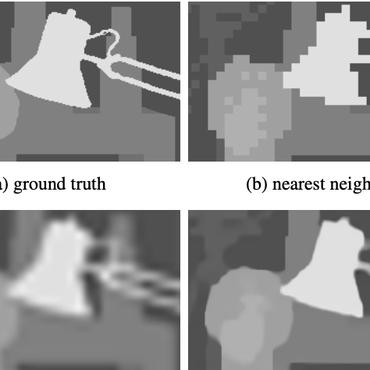Search Results for author: Xinyi Liu
Found 19 papers, 1 papers with code
Deep Representation Learning for Multi-functional Degradation Modeling of Community-dwelling Aging Population
no code implementations • 8 Apr 2024 • Suiyao Chen, Xinyi Liu, Yulei Li, Jing Wu, Handong Yao
As the aging population grows, particularly for the baby boomer generation, the United States is witnessing a significant increase in the elderly population experiencing multifunctional disabilities.
Neurological disorders leading to mechanical dysfunction of the esophagus: an emergent behavior of a neuromechanical dynamical system
no code implementations • 28 Feb 2024 • Guy Elisha, Sourav Halder, Xinyi Liu, Dustin A. Carlson, Peter J. Kahrilas, John E. Pandolfino, Neelesh A. Patankar
Specifically, repetitive antegrade contractions (RACs) are conclusively shown to emerge from the coupled neuromechanical dynamics in response to sustained volumetric distension.
MEDs for PETs: Multilingual Euphemism Disambiguation for Potentially Euphemistic Terms
no code implementations • 25 Jan 2024 • Patrick Lee, Alain Chirino Trujillo, Diana Cuevas Plancarte, Olumide Ebenezer Ojo, Xinyi Liu, Iyanuoluwa Shode, Yuan Zhao, Jing Peng, Anna Feldman
This study investigates the computational processing of euphemisms, a universal linguistic phenomenon, across multiple languages.
Text Classification Based on Knowledge Graphs and Improved Attention Mechanism
no code implementations • 7 Jan 2024 • Siyu Li, Lu Chen, Chenwei Song, Xinyi Liu
To resolve the semantic ambiguity in texts, we propose a model, which innovatively combines a knowledge graph with an improved attention mechanism.
Guided Image Restoration via Simultaneous Feature and Image Guided Fusion
no code implementations • 14 Dec 2023 • Xinyi Liu, Qian Zhao, Jie Liang, Hui Zeng, Deyu Meng, Lei Zhang
Currently, joint image filtering-inspired deep learning-based methods represent the state-of-the-art for GIR tasks.
Guided Online Distillation: Promoting Safe Reinforcement Learning by Offline Demonstration
no code implementations • 18 Sep 2023 • Jinning Li, Xinyi Liu, Banghua Zhu, Jiantao Jiao, Masayoshi Tomizuka, Chen Tang, Wei Zhan
GOLD distills an offline DT policy into a lightweight policy network through guided online safe RL training, which outperforms both the offline DT policy and online safe RL algorithms.
Completing point cloud from few points by Wasserstein GAN and Transformers
no code implementations • 23 Nov 2022 • Xianfeng Wu, Jinhui Qian, Qing Wei, Xianzu Wu, Xinyi Liu, Luxin Hu, Yanli Gong, Zhongyuan Lai, Libing Wu
Inspired by the successful applications of GAN and Transformers in the image-based vision task, we introduce GAN and Transformer techniques to address the above problem.
Tensor Recovery Based on A Novel Non-convex Function Minimax Logarithmic Concave Penalty Function
no code implementations • 25 Jun 2022 • HongBing Zhang, Xinyi Liu, Chang Liu, HongTao Fan, YaJing Li, Xinyun Zhu
The proposed function is generalized to tensor cases, yielding tensor MLCP and weighted tensor $L\gamma$-norm.
LiDAR-guided Stereo Matching with a Spatial Consistency Constraint
no code implementations • 21 Feb 2022 • Yongjun Zhang, Siyuan Zou, Xinyi Liu, Xu Huang, Yi Wan, Yongxiang Yao
Next, we propose a riverbed enhancement function to optimize the cost volume of the LiDAR projection points and their homogeneous pixels to improve the matching robustness.
Low-light Image Enhancement by Retinex Based Algorithm Unrolling and Adjustment
no code implementations • 12 Feb 2022 • Xinyi Liu, Qi Xie, Qian Zhao, Hong Wang, Deyu Meng
Besides, to avoid manually parameter tuning, we also propose a self-supervised fine-tuning strategy, which can always guarantee a promising performance.
Low-Rank Tensor Completion Based on Bivariate Equivalent Minimax-Concave Penalty
no code implementations • 30 Jan 2022 • HongBing Zhang, Xinyi Liu, HongTao Fan, YaJing Li, Yinlin Ye
To makes all the constant parameters of the MCP function as variables so that futherly improving the adaptability to the change of singular values in the LRTC problem, we propose the bivariate equivalent minimax-concave penalty (BEMCP) theorem.
ELSR: Efficient Line Segment Reconstruction With Planes and Points Guidance
no code implementations • CVPR 2022 • Dong Wei, Yi Wan, Yongjun Zhang, Xinyi Liu, Bin Zhang, Xiqi Wang
In this paper, we propose an efficient line segment reconstruction method called ELSR.
Emergency Vehicles Audio Detection and Localization in Autonomous Driving
no code implementations • 30 Sep 2021 • Hongyi Sun, Xinyi Liu, Kecheng Xu, Jinghao Miao, Qi Luo
Hence, all other vehicles are supposed to take proper actions to yield emergency vehicles with active sirens.
Tensor Full Feature Measure and Its Nonconvex Relaxation Applications to Tensor Recovery
no code implementations • 25 Sep 2021 • HongBing Zhang, Xinyi Liu, HongTao Fan, YaJing Li, Yinlin Ye
Tensor sparse modeling as a promising approach, in the whole of science and engineering has been a huge success.
Two New Low Rank Tensor Completion Methods Based on Sum Nuclear Norm
no code implementations • 6 Aug 2021 • HongBing Zhang, Xinyi Liu, HongTao Fan, YaJing Li, Yinlin Ye
This paper proposes a new tensor $L_{2, 1}$ norm minimization model (TLNM) that integrates sum nuclear norm (SNN) method, differing from the classical tensor nuclear norm (TNN)-based tensor completion method, with $L_{2, 1}$ norm and Qatar Riyal decomposition for solving the LRTC problem.
Cancer image classification based on DenseNet model
no code implementations • 23 Nov 2020 • Ziliang Zhong, Muhang Zheng, Huafeng Mai, Jianan Zhao, Xinyi Liu
Computer-aided diagnosis establishes methods for robust assessment of medical image-based examination.
Transfer Learning Robustness in Multi-Class Categorization by Fine-Tuning Pre-Trained Contextualized Language Models
1 code implementation • 8 Sep 2019 • Xinyi Liu, Artit Wangperawong
This study compares the effectiveness and robustness of multi-class categorization of Amazon product data using transfer learning on pre-trained contextualized language models.
Behavior Pattern and Compiled Information Based Performance Prediction in MOOCs
no code implementations • 4 Aug 2019 • Shaojie Qu, Kan Li, Zheyi Fan, Sisi Wu, Xinyi Liu, Zhiguo Huang
This paper mainly focuses on the students' accomplishment behaviors in programming assignments and compiled information from programming assignments.
A Collaborative Approach to Angel and Venture Capital Investment Recommendations
no code implementations • 26 Jul 2018 • Xinyi Liu, Artit Wangperawong
With a similar model, the same dataset was used to generate investor recommendations for companies undergoing fundraising, which achieved highest prediction accuracy of 11. 1%.









